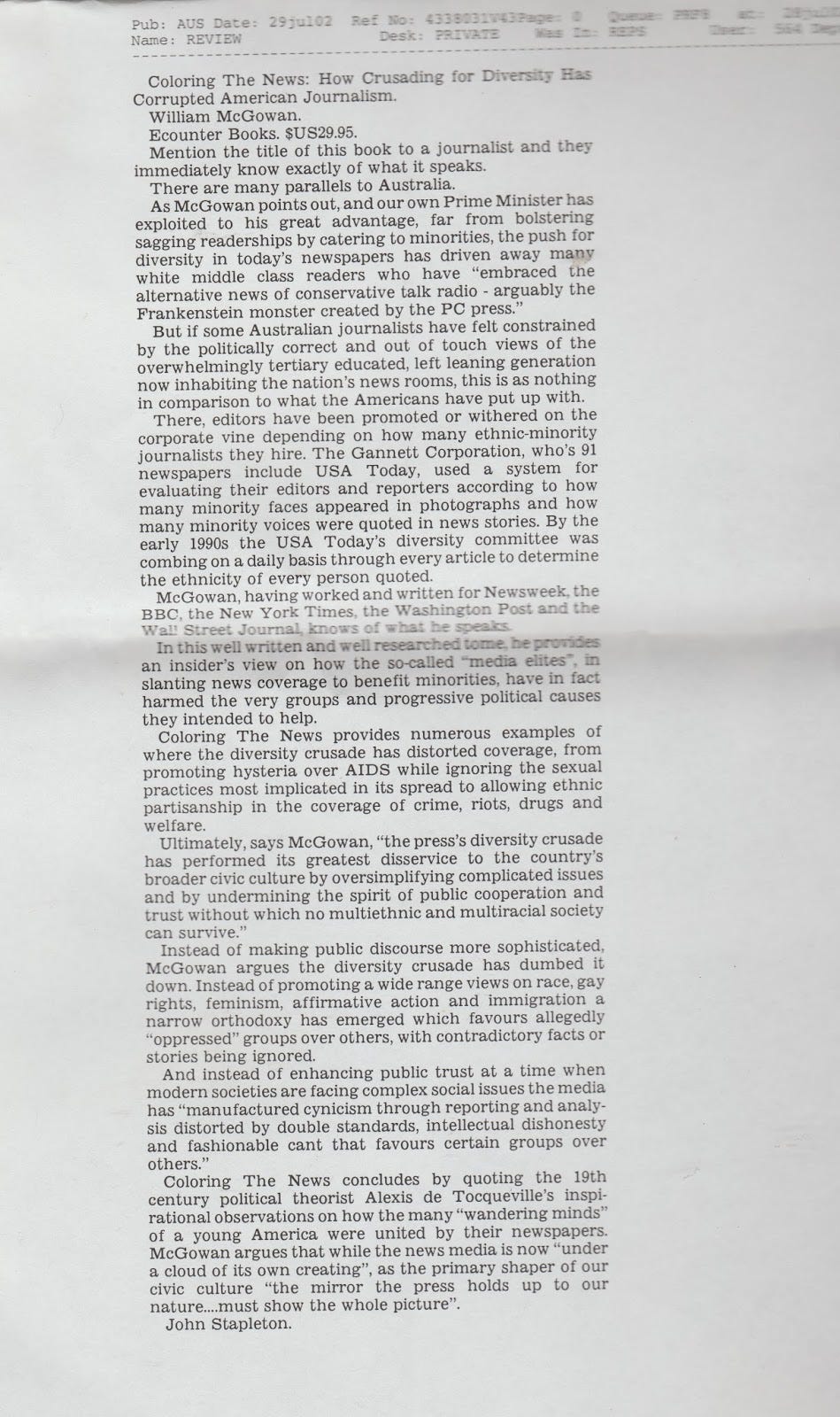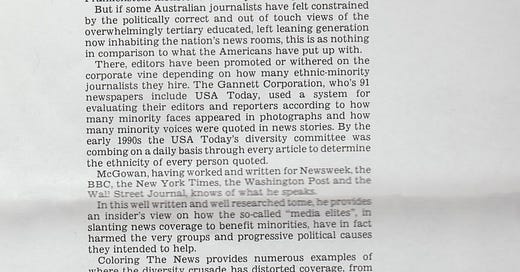Wilful colour-blindness and its damage to media health, The Australian, 11 July, 2002.
Wilful colour-blindness and its damage to media health: [1 Edition]
Stapleton, John. The Australian; Canberra, A.C.T. [Canberra, A.C.T] 11 July 2002: M.09.
Abstract
In Coloring the News, [William McGowan] provides examples of what he sees as the diversity crusade distorting coverage, from promoting hysteria over AIDS while ignoring the sexual practices most implicated in its spread, to allowing ethnic partisanship in thecoverage of crime, riots, drugs and welfare. Ultimately, says McGowan, "the press's diversity crusade has performed its greatest disservice to the country's broader civic culture by oversimplifying complicated issues and by undermining the spirit of public cooperation and trust without which no multi-ethnic and multi- racial society can survive."
Full Text
MEDIA BOOKS
Coloring the News: How Crusading for Diversity has Corrupted American Journalism
By William McGowan, Encounter Books, 278pp, $US29.95
THE subtitle of this book is an increasingly familiar refrain in US journalism, and of growing relevance here.
Author William McGowan argues that US print and electronic media have become slaves to political correctness. He says that far from bolstering sagging readerships by catering to minorities, the push for diversity in today's newspapers has driven away many white middle class readers who have "embraced the alternative news of conservative talk radio -- arguably the Frankenstein's monster created by the [politically correct] press."
In the US, McGowan says editors have been promoted or withered on the corporate vine depending on how many ethnic-minority journalists they hire. The Gannett Corporation, whose 91 newspapers include USA Today, used a system for evaluating their editors and reporters according to how many minority faces appeared in photographs and how many minority voices were quoted in news stories. By the early 1990s the USA Today diversity committee was combing on a daily basis through every article to determine theethnicity of every person quoted.
McGowan, who has worked for Newsweek, the BBC, The New York Times, The Washington Post and The Wall Street Journal, provides an insider's view on how the so-called "media elites", in slanting news coverage to benefit minorities, have in fact harmed thevery groups and progressive political causes they intended to help.
In Coloring the News, McGowan provides examples of what he sees as the diversity crusade distorting coverage, from promoting hysteria over AIDS while ignoring the sexual practices most implicated in its spread, to allowing ethnic partisanship in the coverage of crime, riots, drugs and welfare. Ultimately, says McGowan, "the press's diversity crusade has performed its greatest disservice to thecountry's broader civic culture by oversimplifying complicated issues and by undermining the spirit of public cooperation and trust without which no multi-ethnic and multi- racial society can survive."
Instead of making public discourse more sophisticated, McGowan argues the crusade has dumbed it down. Instead of promoting a wide range views on race, gay rights, feminism, affirmative action and immigration, a narrow orthodoxy has emerged which favours allegedly "oppressed" groups over others, with contradictory facts or stories being ignored.
Coloring The News concludes by quoting the 19th century political theorist Alexis de Tocqueville's inspirational observations on how the many "wandering minds" of a young US were united by their newspapers. McGowan argues that while the news media is now "under a cloud of its own creating", as the primary shaper of our civic culture "the mirror the press holds up to our nature ... must show the whole picture".
ORIGINAL COPY:




